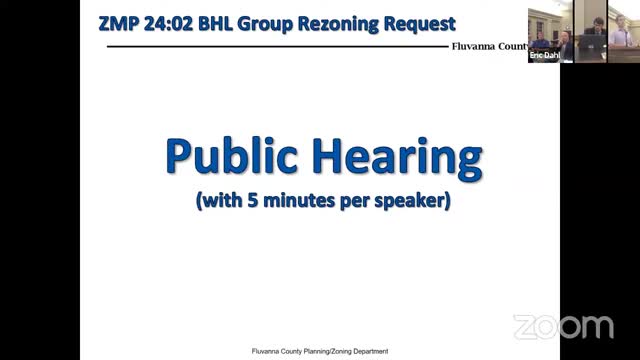Community Divided Over Solar Energy Regulations Debate
July 04, 2024 | Fluvanna County, Virginia

This article was created by AI summarizing key points discussed. AI makes mistakes, so for full details and context, please refer to the video of the full meeting. Please report any errors so we can fix them. Report an error »

In a recent government meeting, significant discussions centered around the future of solar energy projects in Fluvanna County, with community members expressing a range of opinions on the implications of proposed zoning changes. The board considered an amendment to remove utility-scale solar generation facilities as a use allowed by special use permit in the agricultural A-1 zoning district, a move that has sparked considerable debate among residents and officials alike.
Proponents of solar energy, including local farmers and business owners, argued that solar projects could provide much-needed tax revenue and economic benefits to the community. They emphasized the safety and low environmental impact of solar installations, citing successful projects in nearby areas. John Alexander, a former resident and landowner, highlighted the potential for solar facilities to generate revenue with minimal demand for public services, while also expressing concerns about property rights and the long-term implications of zoning changes.
Conversely, opponents raised alarms about the environmental risks associated with solar farms, including water quality issues and the potential for land degradation. Joel Loving, a long-time farmer, voiced strong opposition, asserting that solar farming is not true agriculture and could lead to irreversible loss of farmland. Amanda Sweeney, a local beekeeper, echoed concerns about the visual impact of solar panels on the landscape and the potential decline of agritourism.
The board members acknowledged the complexity of the issue, with some advocating for a cautious approach to ensure that regulations are in place before moving forward with solar projects. Discussions included the need for comprehensive zoning regulations and the establishment of a dedicated solar district to better manage future developments.
Ultimately, the board voted to approve the amendment to remove utility-scale solar generation facilities from the A-1 zoning district, while also directing the solar committee to explore the creation of an S-1 solar district that would allow for agricultural uses alongside solar facilities. This decision reflects a balancing act between fostering economic development through renewable energy and protecting the county's agricultural heritage and environmental integrity. The ongoing dialogue underscores the community's commitment to finding a sustainable path forward in the face of evolving energy needs.
Proponents of solar energy, including local farmers and business owners, argued that solar projects could provide much-needed tax revenue and economic benefits to the community. They emphasized the safety and low environmental impact of solar installations, citing successful projects in nearby areas. John Alexander, a former resident and landowner, highlighted the potential for solar facilities to generate revenue with minimal demand for public services, while also expressing concerns about property rights and the long-term implications of zoning changes.
Conversely, opponents raised alarms about the environmental risks associated with solar farms, including water quality issues and the potential for land degradation. Joel Loving, a long-time farmer, voiced strong opposition, asserting that solar farming is not true agriculture and could lead to irreversible loss of farmland. Amanda Sweeney, a local beekeeper, echoed concerns about the visual impact of solar panels on the landscape and the potential decline of agritourism.
The board members acknowledged the complexity of the issue, with some advocating for a cautious approach to ensure that regulations are in place before moving forward with solar projects. Discussions included the need for comprehensive zoning regulations and the establishment of a dedicated solar district to better manage future developments.
Ultimately, the board voted to approve the amendment to remove utility-scale solar generation facilities from the A-1 zoning district, while also directing the solar committee to explore the creation of an S-1 solar district that would allow for agricultural uses alongside solar facilities. This decision reflects a balancing act between fostering economic development through renewable energy and protecting the county's agricultural heritage and environmental integrity. The ongoing dialogue underscores the community's commitment to finding a sustainable path forward in the face of evolving energy needs.
View full meeting
This article is based on a recent meeting—watch the full video and explore the complete transcript for deeper insights into the discussion.
View full meeting
